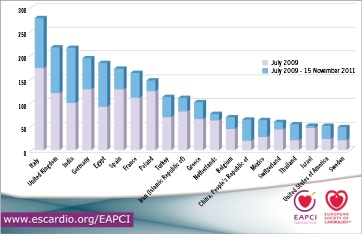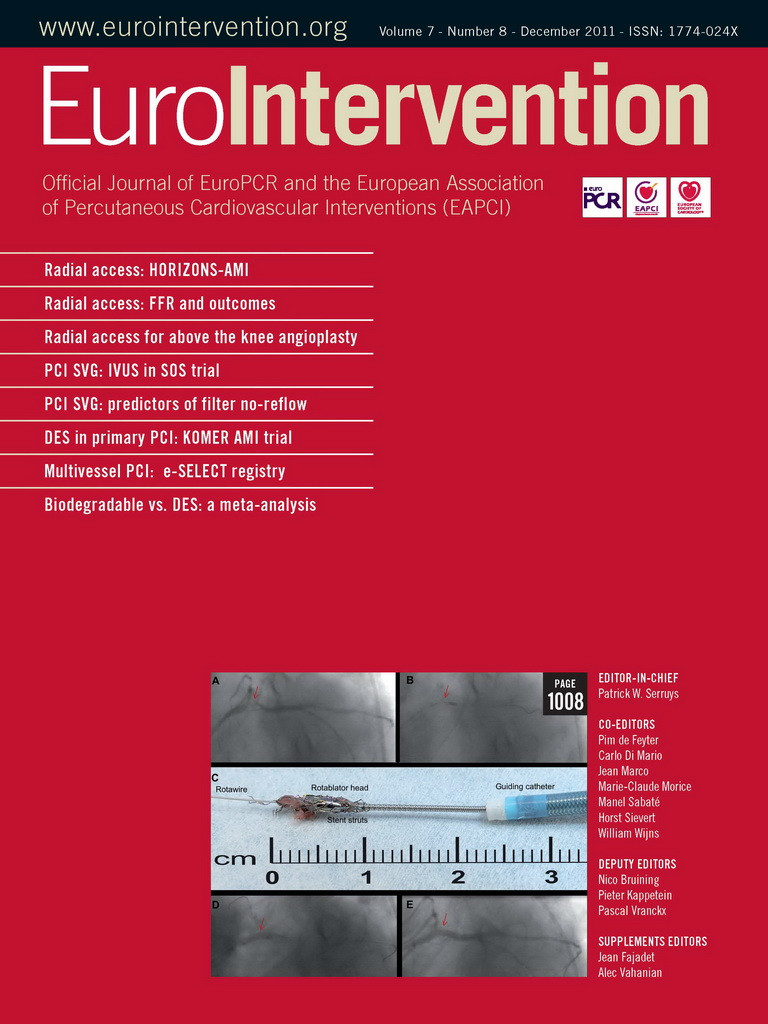As in all translations, a word which in one language captures a multitude of meanings, in another requires many. The French word “rayonnement” is such a word. It can be related to certain forms of energy, to the ability of that energy to “radiate” or illuminate. It also is frequently used in the sense of fulfilment, the idea of reaching maturity, leading to its third meaning, influence, to have increasing influence over its surroundings and peers.
The EAPCI today has a steadily increasing rayonnement, in all senses of the word, maturing on the national and international scene as a professional association. Our continued goals as an active participant, influencing scientific meetings and educational programmes wherever we can, have produced a worldwide recognition of who we are –a rayonnement of the association– that is by no means a chance occurrence, but a conscious desire on the part of myself and the Board to augment and further the agenda of our members as best we can.
EuroPCR
Increasing our visibility is a primary responsibility for the EAPCI, one that we intend to accomplish by the evolution of our interaction and participation in different meetings throughout the world. The first meeting, of course, is our own, EuroPCR, which is a base from which we can build our presence and identity throughout the year.
EuroPCR 2012 will see the launch of what we like to think of as the EAPCI village, a dedicated area of EuroPCR where you will find not only our association, but all those who participate with us, in one location. This will be a natural centre for all our activities, around which you will find all the different National Societies and Working Groups –38 as of today– which we collaborate with, and who play an essential role in the EAPCI. This is a very “hands on” collaboration, active and enthusiastic, and these groups participate fully in EuroPCR. This year these National Societies and Working Groups are responsible for proposing 23 “How should Itreat?” sessions on such topics as coronary artery disease, structural heart disease, peripheral artery disease and the treatment of refractory hypertension. The launching of this dedicated area, this EAPCI village, is a very tangible representation of our work together.
Also during EuroPCR, we will be organising a host of dedicated sessions, including such initiatives as the new spotlight on young interventionalists where we offer them the lead in creating and managing their own symposium. This innovation, which we have mentioned before, will be discussed in detail in future columns.
During EuroPCR, we will also focus on our international participation with such interventional societies as the American College of Cardiology (ACC), with our first joint session, ACC/EAPCI@EuroPCR. Through our integral connection with EuroPCR, we will also continue working closely with other interventional groups: the South American SOLACI, CCT of Japan and CIT of China.
Here and abroad
No matter how international we become, our foundations remain European. We are an active participant within our parent organisation, the European Society of Cardiology (ESC). Our involvement here continues to expand, as it did last year, in the creation of the scientific programme of the ESC annual meeting itself. This coming year we are proposing a session in collaboration with the American College of Cardiology.
Together we are all working towards the same goals; within the framework of an organisation such as the ESC made up of many parts, we believe firmly that what promotes one, promotes all. We are part of the ESC council, composed of the other member Associations and Working Groups, and in 2012 will organise the EAPCI summit on Friday May 4th. This is a meeting for all the Working Groups and National Societies represented by their Presidents. The theme this year is education, and the new ESC eLearning platform (ESC EL) will be presented and we will discuss this in detail here in the future.
The presence throughout the year of EAPCI representatives at meetings in Europe and worldwide is also of great importance to our association. We feel this is essential in order to increase the interchange and better understand the local situation and needs of each region, to help diffuse guidelines and provide the most effective educational material and tools. The feedback and exchange from these encounters is valuable, and in the coming months the EACPI will be present at the meetings of National Societies and Working Groups via the organisation of specific joint-sessions in countries such as Germany and Poland. The future will also see other unique sessions in Europe, such as the one in planning with the Russian Society of Cardiology in 2012.
Outside of Europe, and in the same spirit of collaboration, we have proposed and will organise a joint session EAPCI-EuroPCR/ESC@CIT in Beijing, China, March 15 to 18, 2012.
Growing momentum
We have the real pleasure of seeing that our actions, and those of our predecessors, have begun to bear fruit. From September 2009 to the present, our membership has increased more than 50%, growing incredibly from 2,110 to 3,557. While it is true that, as we discussed above, we have a truly global outlook, the interventional world also looks towards us with now our members come from 115 countries, increasing from 97 only two years ago. International, yes, but still 72% of our members come from ESC member countries. Figure1 shows the evolution and breakdown of our association, for which we should all be proud, and points to the future of the EAPCI.

Figure 1. EAPCI membership evolution of the top 20 countries from July 2009 to 15 November 2011.
In short, our projects and goals depend on the recognition of our association on a national and international stage. Our presence at international meetings and our increasing enrolment are all tied together, and allow the EAPCI to have an influence –a rayonnement– where it matters: to effectively further the needs of our members in their education and practice here in Europe, and throughout the entire world.

